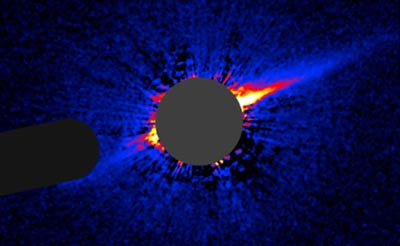30 July 2007

Credit: NASA, ESA, and P. Kalas (University of California, Berkeley)
Astronomers using the Hubble Space Telescope and the giant W.M. Keck Observatory have found an irregular disk of debris around a young star known as HD 15115. As viewed from Earth, the edge-on disk resembles a needle sticking out from the star.
Astronomers believe the disk's odd asymmetrical shape is the resultant dust following a highly elliptical orbit around the star. The disk may have originated by the gravitational influence of planets sweeping up debris in the disk or by the gravity of a nearby star.
The observations were made by Paul Kalas, James Graham, and Michael P. Fitzgerald (University of California, Berkeley). Their paper was published in The Astrophysical Journal Letters. "The lopsided disk presents a host of new challenges for theorists," said Kalas.
Debris disks are believed to be produced by dust from collisions among protoplanetary objects, which are the building blocks of planets. These dusty disks can be affected by planets nearer to the star;.Similarly, Jupiter's gravity influences asteroids in the asteroid belt.
This discovery is consistent with models of the evolution of our own Solar System, where Neptune may have initially formed between the orbits of Saturn and Uranus. Neptune was eventually kicked out to its current orbit by gravitational interactions between Saturn and Jupiter before their orbits stabilized.
"Therefore, we speculate that if such a planetary upheaval were occurring around HD 15115 at the present time, it could explain the highly asymmetric disk," said Kalas.
Kalas is also investigating whether the disk's irregular shape resulted due to a close encounter between its star and another star, known as HIP 12545, located about 10 light years from HD 15115.
Dusty disks are known to exist around at least 100 stars, but only less than a dozen cases are well-studied. This is due to the difficulty of observing faint material in the glare of a star.
HD 15115 and HIP 12545 are among nearly 30 stars that are members of the Beta Pictoris Moving Group. Moving groups are expanded clusters of stars believed to have a common birthplace and age that are moving loosely together through space.
The dusty disk around HD 15115 was first detected by infrared observations in 2000. In 2006, the Hubble Space Telescope confirmed the existence of the disk by resolving the disk in reflected light for the first time. The disk was further studied in Keck Observatory in 2006 and 2007.
"The disk was seen in the HST data, but its appearance was so extraordinary we could not be certain that it was real. It took follow-up observations at Keck to confirm that it was a real disk," said Kalas.
Further Reading
Astronomers Find Highly Elliptical Disk around Young Star
http://hubblesite.org/newscenter/archive/releases/2007/28/full/
Hubble Observations Provide Insight into Planet Birth
http://hubblesite.org/newscenter/archive/releases/2007/02/layout/thumb/
Dusty Planetary Disks around Two nearby Stars Resemble Our Kuiper
http://hubblesite.org/newscenter/archive/releases/2006/05/layout/thumb/
Aymen Mohamed Ibrahem